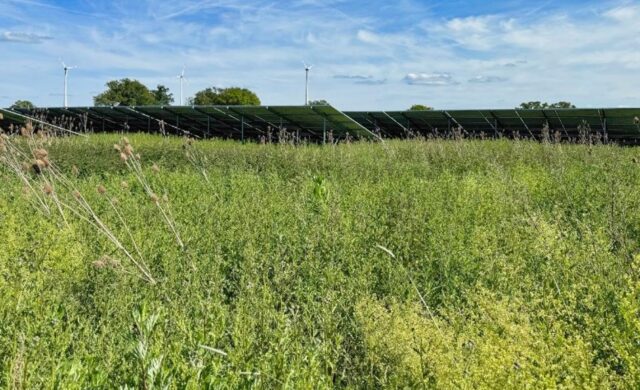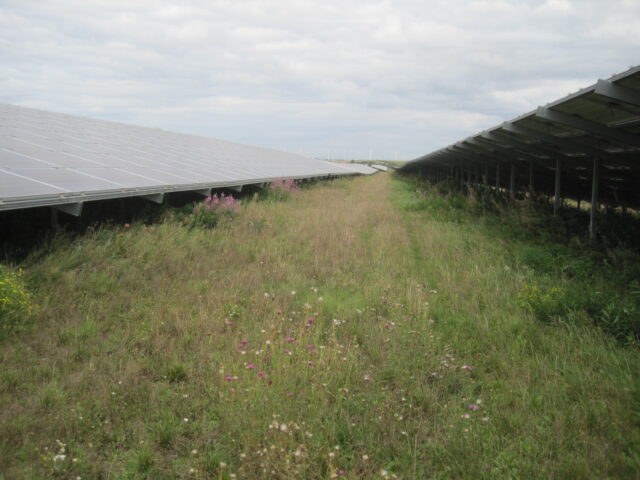Freimersheim solar park
The Freimersheim solar park operated by JUWI GmbH is located around 100 metres south-west of the Rhineland-Palatinate town of Freimersheim. It was commissioned in 2012 and covers 11.7 hectares along a railway line. It is one of the oldest facilities in our study. The wide gravel paths and partial gravel between the rows of modules are striking.

JUWI GmbH
8 MW
12 ha
2012
Rhineland-Palatinate
49.7024125693 - 8.06881130449
Arable land
Table of contents
| Species groups | Investigated |
|---|---|
| Plants | ✔ |
| Locusts | ✔ |
| Butterfly | ✔ |
| Dragonflies | |
| Reptiles | ✔ |
| Amphibians | |
| Birds | ✔ |
| Bats | ✔ |
| Miscellaneous |
✔ = Investigation carried out on behalf of the operators
Natural environment and special features
Upper Rhine lowlands and Rhine-Main lowlands
The site is surrounded by agricultural landscape with a high proportion of rapeseed. A dense hedge structure with scattered trees (overstorey) runs to the south of the site. A little-used railway line runs parallel to and in the immediate vicinity of the hedge structure. The EU bird sanctuary "Ackerplateau zwischen Ilbesheim und Flomborn" begins to the south of the railway line. There is another PV system to the west of the plant. The railway line, the hedge structure and the PV system under investigation are located in a slight valley in relation to the wider surroundings. There are no notable bodies of water in the immediate vicinity of the plant.
The site is located at around 280 metres above sea level on a gentle slope and slopes down towards the east.
Arable land, <1% Grass tracks
Floor
Pararendzina of loess alternating with Rendzina of marl and limestone
Clay slurries
Construction method
0.5
4m
2.9m
25°
8 pieces
10mm
The frame is a double-post frame driven into the ground.
The modules are polycrystalline and monofacial.
New paths were created. All of the development paths within the building boundary that did not yet exist were paved as gravelled turf.
There are varying row spacings of 3.6 to 5.5 metres in the system. The fence also has a 15 cm high passage for small animals.
Management
The area is mowed twice a year. The first time in May or June and the second time in August or September. It is mulched as required using flail mowers and swivel discs with sickle mowers. The tramlines are mown first. The mowing under the tables then follows with a two-week delay.
Equalisation measures
The following compensatory measures were implemented:
Measure 1: Within the special area for photovoltaics, all unsealed areas are to be developed as rough grassland and extensively maintained (with the exception of the areas for the shrub hedges, paths and access roads).
Measure 2: At least one three-row shrub hedge with a total planting area of 3,500 m² must be planted in sections in the north between the module areas and the neighbouring farmland and farm tracks. The width including the border is 8 metres. The north-western section of the northern boundary is excluded from the planting, as a biotope-mapped hedge already exists here. The planting measures should be completed no later than two years after the start of construction. Shrub groups in the south, west and east (total area of at least 1,250 m²). The minimum length of the individual groups of bushes should be 20 metres.
The compensatory measures for habitat loss of the species skylark (4 territories), grey wagtail (2 territories) and grey partridge (3 territories) are to be implemented by the farmers in the area of the bird sanctuary as farm-integrated measures (management measures). Extensive management of the remaining areas in the solar park has also been specified.
External CEF measure: 5 flower strips 100 metres long and 10 metres wide (including 2 metres of fallow land) and 5 skylark windows. According to the environmental report, the measure is also intended to compensate for the loss of territories of grey wagtails and grey partridges.
Test results
Further documents
Development plan
Freimersheim solar park development planEnvironmental report
Environmental report Freimersheim solar parkDocumentation of the implementation of measures
Documentation on the implementation of measures at the Freimersheim solar parkMonitoring sheet - Extensive grassland 2018
Monitoring sheet - Extensive grassland 2018 Freimersheim solar parkMonitoring sheet - hedge planting 2018
Monitoring sheet - hedge planting 2018 Freimersheim solar parkInvestigation report research project TH Bingen
Investigation report research project TH Bingen Freimersheim solar park









